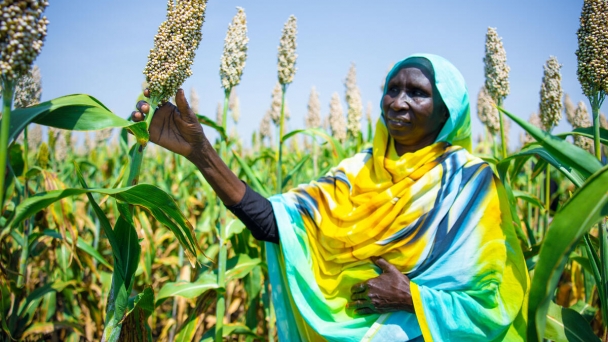December 12, 2024 | 05:00 GMT +7
December 12, 2024 | 05:00 GMT +7
Hotline: 0913.378.918
December 12, 2024 | 05:00 GMT +7
Hotline: 0913.378.918

An Afghan farmer holds urea fertilizer in his hand. Sustainable fertilizer management has the potential to decrease Nitrous oxide emissions.
Nitrous oxide (N₂O), a potent greenhouse gas, is rapidly accelerating climate change and damaging the ozone layer, jeopardizing the 1.5°C warming target and posing a serious threat to public health, according to a new United Nations Global Nitrous Oxide Assessment.
Launched at the 2024 United Nations Climate Change Conference (COP29) in Baku, Azerbaijan, the Assessment, published by the United Nations Environment Programme (UNEP) and the Food and Agriculture Organization of the United Nations (FAO), signals that emissions are rising faster than expected, and that immediate action is required to curb the environmental and health impacts of this super pollutant.
Nitrous oxide is approximately 270 times more potent than carbon dioxide in terms of warming the planet, and currently responsible for approximately 10 percent of net global warming since the industrial revolution. Primarily emitted from agricultural practices such as the use of synthetic fertilizers and manure, N₂O is the third most significant greenhouse gas and the top ozone-depleting substance still being released into the atmosphere.
Nitrous oxide is currently the most significant ozone-layer depleting substance being emitted into the atmosphere. The Assessment shows that proactively tackling N₂O would also support the continued recovery of the ozone layer, helping to avoid a future where much of the global population is exposed to harmful UV levels.
The Assessment's key findings include:
The findings from the Assessment are clear: urgent action on N₂O is critical to achieving climate goals, and without a serious reduction in emissions, there is no viable path to limiting warming to 1.5°C in the context of sustainable development as outlined in the Paris Agreement. Abating N₂O emissions could avoid up to 235 billion tonnes of CO₂-equivalent emissions by 2100 – the equivalent of six years' worth of current global carbon dioxide emissions from fossil fuels.
This Assessment identifies practical, cross-sectoral abatement strategies that could cut N₂O emissions by more than 40 percent from current levels. Through transforming food production systems and rethinking societal approaches to nitrogen management, even deeper reductions could be achieved, offering a critical opportunity to move the world closer to its climate, environmental, and health goals.
The Assessment also shows that N₂O emissions from the chemical industry can be quickly and cost-effectively abated; agricultural and industrial practices impact the natural nitrogen cycle, leading to increased N₂O emissions.
Simultaneously reducing nitrogen oxide emissions and ammonia would also significantly improve air quality, potentially avoiding up to 20 million premature deaths globally by 2050. Abatement measures would also enhance water quality, improve soil health, and protect ecosystems from the impacts of nitrogen runoff.
The Assessment underscores the need for immediate and ambitious action to reduce N₂O emissions, as part of a broader strategy to tackle super pollutants, which, alongside efforts to achieve net-zero carbon dioxide emissions, will put the world on track to meet long-term climate, food security, and health goals.
“Addressing nitrous oxide emissions is essential for ensuring sustainable, inclusive and resilient agriculture that simultaneously helps countries achieve their climate and food security goals. As the Assessment clearly shows, there are ways to produce more with less, by improving the efficiency of nitrogen use in agriculture and reducing excessive nitrogen application,” said Kaveh Zahedi, Director of FAO’s Office of Climate Change, Biodiversity and Environment.
“Abating N₂O emissions could avoid up to 235 billion tonnes of CO₂-equivalent emissions by 2100,” stated David Kanter, Associate Professor of Environmental Studies, NYU and Co-Chair of the Assessment. “This is equivalent to six years' worth of current global carbon dioxide emissions from fossil fuels.”
"A sustainable nitrogen management approach not only reduces nitrous oxide emissions but also prevents the release of other harmful nitrogen compounds," said A.R. Ravishankara, chemist and atmospheric scientist, Colorado State University and Co-Chair of the Assessment. "This could improve air and water quality, protect ecosystems, and safeguard human health, all while maintaining food security."
“The ozone layer is crucial for all life on Earth. For decades, parties to the Montreal Protocol have worked hard to safeguard it. This Assessment highlights the need for continued vigilance, commitment and action for the ozone layer to recover as soon as possible to its pre-1980 levels,” said Megumi Seki, Executive Secretary of the Montreal Protocol Ozone Secretariat, United Nations Environment Programme.
“This Assessment sounds the alarm on a relatively forgotten super pollutant that contributes greatly to climate change and air pollution,” said Martina Otto, Head of Secretariat of the UNEP-convened Climate and Clean Air Coalition.
“By using the abatement tools highlighted in the Assessment that are already available to us, we can yield multiple benefits across climate, clean air, and health,” she added.
The UNEP-convened Climate and Clean Air Coalition (CCAC) is a partnership of over 180 governments, intergovernmental organizations, and non-governmental organizations. It works to reduce powerful super pollutants that drive both climate change and air pollution. It aims to connect ambitious agenda setting with targeted mitigation action within countries and sectors. Robust science and analysis underpin its efforts and bolstered by its trust fund, the CCAC has given rise to high-level political commitment, in-country support, and a range of tools that support the case for action and implementation.
The International Nitrogen Management System (INMS) is a global scientific support process for international nitrogen policy development. It is implemented by UNEP with funding from the Global Environment Facility (GEF). The INMS process is hosted by UKCEH, which is a collaborative partner with UNEP, underpinned by a MoU between both organizations. In 2025, INMS will publish the International Nitrogen Assessment which produced the low and high ambition nitrogen abatement scenarios which contributed to the Global Nitrous Oxide assessment.
The Montreal Protocol Ozone Secretariat is based in Nairobi, Kenya, housed within UNEP. It is the Secretariat for two very important ozone protection treaties/agreements: the Vienna Convention for the Protection of the Ozone Layer and the Montreal Protocol on Substances that Deplete the Ozone Layer. Both play a major role in protecting the ozone layer and reducing its depletion, and in turn protecting the environment. The Secretariat’s mission is to facilitate the effective implementation of the Vienna Convention and the Montreal Protocol and its amendments.
(FAO)

(VAN) As stakeholders engage in collaboration and participation, the value chain becomes more comprehensive and sustainable, thereby advancing Vietnam's seaweed industry to greater heights.

(VAN) Inaugural gathering of global platform is co-organized by Thailand and FAO.

(VAN) Unprecedented concerns from UK farmers over proposed changes to the RSPCA’s Welfare Standards for Laying hens have led to a further climbdown by the assurance scheme.

(VAN) Thanh Hoa paid forest environmental service payments of VND 30–35 billion annually for nearly 400,000 ha of forest, raising forest protection awareness.

(VAN) UK retailer Coop has announced it will extend its improved poultry welfare standards across its convenience range.

(VAN) Escalating violence continues to drive extreme hunger crises from Gaza to the Sudan and Haiti.

(VAN) To contribute to the sustainable development of aquaculture, scientists have conducted experiments to determine the waste load from lobster farming activities.